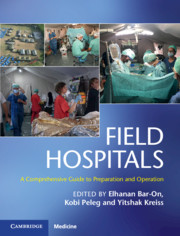Book contents
- Field Hospitals
- Field Hospitals
- Copyright page
- Contents
- Contributors
- Preface
- Section 1 History
- Chapter 1 History of Military Field Hospitals
- Chapter 2 Caring for Weapon Wounded
- Section 2 Scenarios
- Section 3 Operational Considerations
- Section 4 Clinical Considerations
- Section 5 Additional Contextual Considerations
- Index
- Plate Section (PDF Only)
- References
Chapter 2 - Caring for Weapon Wounded
The Red Cross Experience from Solferino to the International Committee of the Red Cross Hospitals
from Section 1 - History
Published online by Cambridge University Press: 09 January 2020
- Field Hospitals
- Field Hospitals
- Copyright page
- Contents
- Contributors
- Preface
- Section 1 History
- Chapter 1 History of Military Field Hospitals
- Chapter 2 Caring for Weapon Wounded
- Section 2 Scenarios
- Section 3 Operational Considerations
- Section 4 Clinical Considerations
- Section 5 Additional Contextual Considerations
- Index
- Plate Section (PDF Only)
- References
Summary
The ICRC was founded in 1863 and, in 1864, the first Geneva convention was created. It states that wounded and sick in armed conflict should receive assistance. They and the medical staff caring for them are protected by the emblem of the Red Cross, meaning that they must not be attacked.
War surgery is a major activity of the ICRC. From 1979, independent hospitals have been set up by the ICRC for wounded from conflict areas such as Afghanistan, Cambodia, and Sudan, and more than 100 000 wounded have received treatment. Treatment is always free of charge and medical needs are the only reasons for admission, so both soldiers and fighters from different groups are treated.
Expatriate doctors and nurses are civilians, doing missions as volunteers and usually staying between three months and a year. Most come from Europe, but many are from Canada, Australia, and New Zealand. Many have no previous experience of treating weapon wounds. Basic equipment is provided, but based on the long experience of ICRC, guidelines and treatment protocols have been created with the aim of saving life and limbs and rehabilitating the wounded. Even with these limited resources, hospital mortality is only 2.2–6.4%.
Keywords
- Type
- Chapter
- Information
- Field HospitalsA Comprehensive Guide to Preparation and Operation, pp. 12 - 16Publisher: Cambridge University PressPrint publication year: 2020



